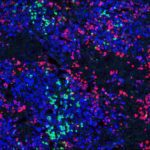Lien vers Pubmed [PMID] – 26893346
Development 2016 Apr;143(7):1149-59
To identify cell-based decisions implicated in morphogenesis of the mammalian liver, we performed clonal analysis of hepatocytes/hepatoblasts in mouse liver development, using a knock-in allele of Hnf4a/laacZ This transgene randomly undergoes a low frequency of recombination that generates a functional lacZ gene that produces β-galactosidase in tissues in which Hnf4a is expressed. Two types of β-galactosidase-positive clones were found. Most have undergone three to eight cell divisions and result from independent events (Luria-Delbrück fluctuation test); we calculate that they arose between E8.5 and E13.5. A second class was mega-clones derived from early endoderm progenitors, generating many descendants. Some originated from multi-potential founder cells, with labeled cells in the liver, pancreas and/or intestine. A few mega-clones populate only one side of the liver, indicating hepatic cell chirality. The patterns of labeled cells indicate cohesive and often oriented growth, notably in broad radial stripes, potentially implicated in the formation of liver lobes. This retrospective clonal analysis gives novel insights into clonal origins, cell behavior of progenitors and distinct properties of endoderm cells that underlie the formation and morphogenesis of the liver.


